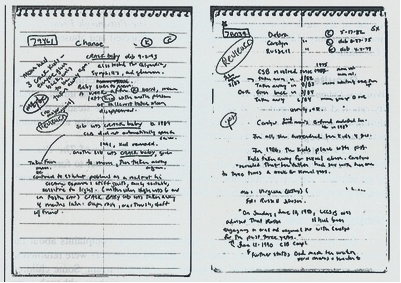
(See related pages)
For several years, Roe says, he had been hearing complaints about the Lucas County Children Services. Too often, abused youngsters were returned to homes where they were battered, molested or neglected again. Some children were placed with relatives, friends and previously absent fathers, although some of these people were drug users, sex offenders and child abusers. Children Services often waited months, sometimes years, before removing children from such homes. To do the story properly, Roe needed records, documents that proved—or disproved—the rumors. But children's records are confidential. Roe was helped by two of the traditional aids of the reporter: a source and Roe's knowledge of the system. The source had in a downtown basement copies of complete files of Children Services' records. But the records were voluminous, and it would take months to pour through them for a representative group. Roe decided to use only cases of children currently in foster care, most of whom had been in the system many years. But the names of foster children are confidential. "Then I discovered a useful bit of information," Roe says. "Foster parents receive monthly checks for caring for abused children." He knew that the county auditor issued the checks, which are public. By obtaining names from the list of the issued checks, he was able to find what he needed in the files in the basement. The Files Roe said he found a "wealth of information that included police reports, social histories, psychiatrists' reports and school records." Some of the files were a foot thick, and they were all up-to-date. "At first, I wasn't sure what I would find," Roe said. "But after reading through the first few cases I knew I was on to something. "One of the first cases involved a mother who had abused and neglected her children for years. Twice officials took them away, and twice they were returned to her. "They even gave the kids back after her infant son died of pneumonia on a night she left him home alone so she could go cruising with friends. Officials never arrested her, though they could have several times." As he read through the cases, patterns became apparent:
These groupings became the basis of the organization of Roe's story. "If the file indicated the child was a cocaine baby, I put a circled C on the page. If officials had to remove the child more than once, I wrote down '2X' or '3X.'"
The Writing By organizing his notes by themes, Roe was able to structure his articles. Then he went back to the files and took detailed notes on the cases that supported these themes. (His source would not allow Roe to make copies of the files.) "By now, I realized that my story was more than an exposé of Children Services. The entire system, including doctors, lawyers, judges and social workers, was often to blame when kids fell through the cracks." Roe did not want his story to read like a records-search story. "So I tracked down parents, children and officials in several key cases. Their quotes and anecdotes help bring the stories to life." His work led to a four-part series, which begins:
The Reaction The Lucas county commissioners called for a special meeting with Children Services immediately after the fourth article in Roe's series ran. There were a total of 17 front-page follow-up stories, one of which, Roe said, "broke the agency's back. A few days after the series, with pressure mounting, a 5-year-old boy was found, bound, beaten and bloodied in his home. Police took him to the hospital, then Children Services for safekeeping. But officials there returned him home hours later. Only after the police complained did the agency go back and remove the child." Two days after Roe wrote about this, the agency announced it would overhaul the system. A month later, Roe wrote:
|
